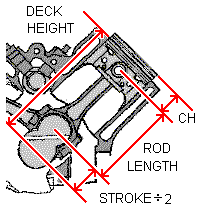
No matter if you have a Ford Mustang, Chevy Camaro, Corvette, hot rods or roadster, stock engine parts or performance parts, the foundation of every engine project is the "Short Block." Basically, this includes the engine block, crank, rods and pistons.
While these are simple parts, common to all engines, there are many misconceptions regarding the short block. Large amounts of horsepower can be lost or gained by the combination of engine parts used in the short block.
Out With The Old
To start, let's clear out a common short block misconception. Some people think rod length changes stroke. This is not true. The crankshaft must be replaced or re-ground if you wish to change stroke. Stroke is the distance the piston travels up or down in the cylinder.
If you change the engine stroke, engine parts such as the rods may need to be changed. But, changing the rods alone does not change the stroke.
Rod length can impact compression ratio and change the engine's performance, but let's save this little tidbit for later.
Short Block Fundamentals
As an engine builder, there are several key dimensions you must address in the short block. They are stroke, rod length, piston compression height and block deck height.
Engine stroke is determined by the crankshaft. The engine parts manufacturer or a machine shop can supply this measurement.
Rod length is measured as the distance from the center of the wrist pin hole to the center of the big hole.
Piston compression height is the measurement from the center of the wrist pin hole to the deck of the piston. On pop-up pistons, the deck is the level part on top of the piston that would be smooth if it were a flat top piston.
Block deck height is the distance from the center of the crankshaft to the top of the deck where the head is bolted.

Putting The Pieces Together
If the wrong combination of engine performance parts is used then the piston will end up sticking out of the block (as shown in the illustration above).
Pistons with excess compression height, longer rods or a stroker crank could cause the problem (shown above). A less obvious problem can occur due to machine work on the block.
It is not uncommon for a refurbished block to be "deck cut." This is done to square and level the top surface so the mating surface of the head fits better during final assembly.
It is not uncommon for a block to be "decked" to the point where stock dimension parts will result in the piston sticking out of the block.
Although we have only been dealing with four dimensions, knowing these measurements is critical. All to often these dimensions are neglected or unknown. For example, your block was probably someone else's "return core," so, don't take it for granted the block dimension is the stock height.
The nice part of the Engine Shop software is that it automatically grinds out the math to verify that your proposed engine combination will keep the pistons in the block.
Avoiding Performance Problems
Simply buying performance parts does not guarantee better engine performance. This is especially true when working with the short block.
It is possible to buy a higher compression ratio piston but actually end up with less compression than you started with in your engine.
For example, suppose you replace a flat top piston with a "pop up" piston advertised to give you more compression. If the compression height is too short on the new piston the piston will be deeper in the cylinder and you will have a smaller compression ratio that the old flat top piston.
All to often pistons are bought mail order or at a swap meet based on an advertised compression ratio. Again, the compression height isn't checked at all, or until there is a problem.
So, it is possible to build an engine with 12.5:1 pistons but in reality have only 8 or 9:1 compression ratio due to a shorter piston compression height.
Again, the advantage to using the Engine Shop software is that it continually checks the compression height before it displays your engine's compression ratio. This helps you avoid a performance problem
Rod Length Tidbits
The rod length and the piston's compression height are common adjustments that determine the final position of the piston's top at the end of the stroke.
In the previous example, where a shorter compression height piston reduced the final compression ratio, a longer rod could be used to correct such a problem.
So, the next time you hear someone say they put longer rods in their engine and made a huge gain in horsepower (like 50 or 100) you now know that they most likely were using the wrong piston/rod combination to start with.
The other thing to remember about rod length is that if you want to replace your existing rods with longer ones, you are more than likely going to need shorter compression height pistons, too!
An advantage of using the Engine Shop software is that it checks these short block dimensions anytime you make a change to the parts in the short block. Not only does Engine Shop update the compression ration when you modify the short block it also alerts you of a pending problem such as the piston sticking above the block deck.
Another advantage of the Engine Shop software is that it has the stock short block dimensions for typical Chevy, Ford, and Mopar engines are buil-in.